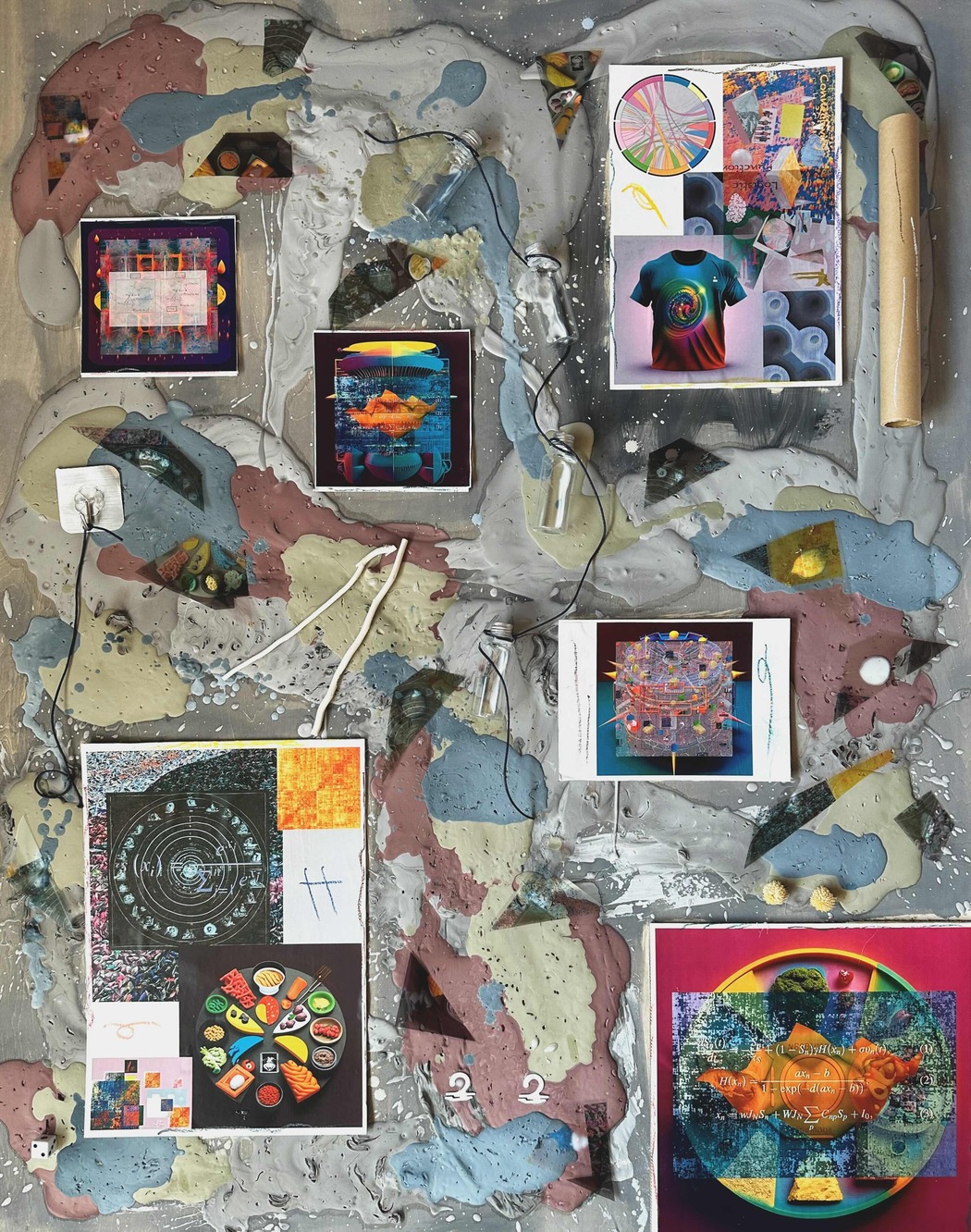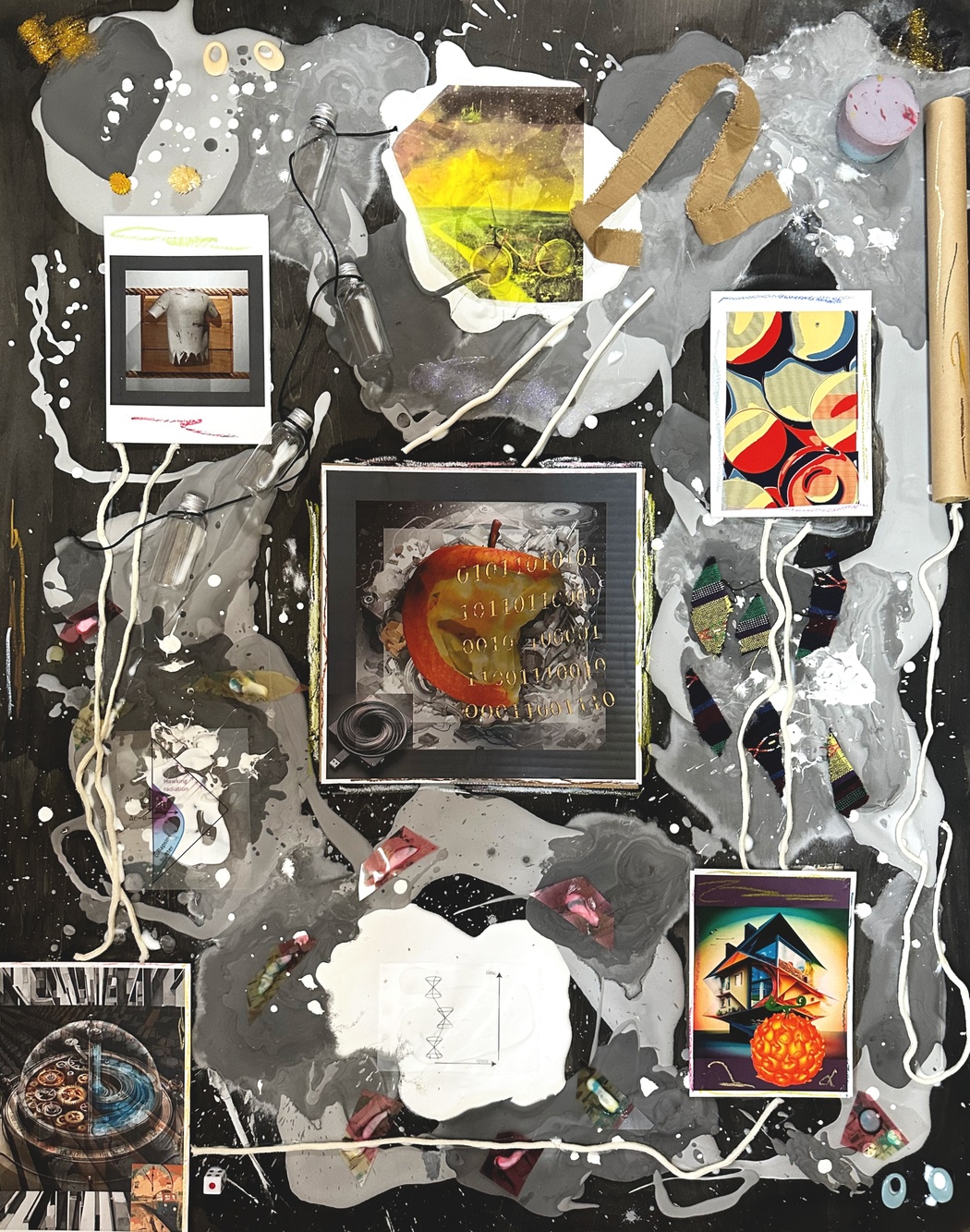Humans Sato
Year of birth: 1971
Where do you live: Kanagawa, Japan
Your education: Tokyo Institute of Technology, Graduate School of Science and Engineering, Department of Physics, Ph. D. of Science
Describe your art in three words: Physics, Collage, Aufheben
Website | Instagram
Your background spans theoretical physics, financial industry, and computational biology. How do these diverse fields influence your approach to creating art?
The objects described by classical mechanics and the theory of relativity are robust processes that follow classical causality. The objects that quantum mechanics, finance, and living things deal with stochastic progress, and are therefore considered fragile. I believe that the universe and macroscopic things are robust, while humans and things created by humans are fragile. I create works that use robust theoretical physics and geometric concepts as motifs, as well as fragile statistical mechanical approaches to mathematical biology that target humans and life. I also create works that are critical of financial engineering.
How do you integrate concepts from mathematical oncology and computational neuroscience into your artworks?
In mathematical oncology, I have created works using the process that follows the evolutionary model of cancer, and in computational neuroscience, I have created works using models of neural firing themselves and images visualized from fMRI image data, but I tend to deal with themes in theoretical physics, geometry, and mathematical biology rather than mathematical oncology or computational neuroscience. In theoretical physics, I often deal with the cutting-edge research results of cosmology, superstring theory, and modern physics, in geometry, concepts that appear in differential geometry and algebraic geometry, and in mathematical biology, I often deal with the stochastic or statistical mechanical models of biological evolution.
 Humans Sato, Computational Neuroscience, 2024
Humans Sato, Computational Neuroscience, 2024
Your artist statement mentions the loss of humanity due to over-concentration on physics. How do you ensure that your current work balances science and human experience?
I try to live my daily life neither too focused on research nor too focused on art. Doing music is part of that. Whether I can get success as an artist or not, I have no intention of quitting my job at the moment. This is to keep a balance in my daily life and mental state, and also because I don’t want to lose my identity as a scientist. Also, I eat dinner at an izakaya once a week.
You are influenced by artists such as Wassily Kandinsky and Salvador Dali. How do their styles or philosophies resonate with your scientific background?
I am also influenced by the Bauhaus and Surrealism of Wassily Kandinsky and Salvador Dali , but I am most strongly influenced by Japanese artists. The spiritual pillar of my art is the Japanese avant-garde artist Taro Okamoto. With more time spent at home due to the COVID-19 pandemic, I was triggered to create art after reading his book “Today’s Art” when he was still alive. I was impressed by the words in the book, “It doesn’t matter if you’re not good at it, there’s meaning in ordinary people drawing,” and I started creating art. In terms of style, I think I am strongly influenced by Shinro Ohtake, a living Japanese artist who also creates avant-garde works. My initial goal when I went to an exhibition of his work was to be like Shinro Ohtake, who can also create digital works.
Could you elaborate on your creative process when fusing visible and invisible concepts in your artworks?
In a word, it means looking at things from various aspects and consolidating various representations into one work. It’s like writing a paper. A paper is composed of the results of hand calculations, computer simulations, references, etc. Hand calculations, simulation results, and references are each image that makes up my collage works. These are consolidated into one work. Many of these images are conflicting each other, and objects that promote or alleviate the conflict are placed on the screen. Two or more opposing things are placed and sublimated to create a single work. This is what Hegel calls “Aufheben.” Taro Okamoto called the same thing “oppositionism.” In my research, new discoveries and theories are created by fusing different fields of thinking and ways of looking at things from various angles. The approach I take when I come up with an idea for an art piece is the same approach I take when I come up with a new idea in my study.
 Humans Sato, Black Hole Hard Disk, 2024
Humans Sato, Black Hole Hard Disk, 2024
What role does augmented reality (AR) and virtual reality (VR) play in your artistic vision?
VR works is that it invites visitors into an immersive experience. Moreover, because it is done in a digital space, it can be achieved at low cost. My immersive experience started when I soaked in the Naoshima public bath ” I LOVE Bath” created by Shinro Ohtake on the island of Naoshima in the Seto Inland Sea, Japan. I was able to fully enjoy the world of Shinro Ohtake by soaking in the bath surrounded by his works. This autumn, I will also be experiencing the three-dimensional mandala of Toji Temple in Kyoto, created by the esoteric Buddhist monk Kukai nearly 1,200 years ago.
What is the significance of J-pop music in your creative process, and how does it influence your visual or conceptual approach?
I am also working on a music piece to add background music to my VR and video work. This is essential to the immersive experience of my work. I thought that even when artists create music, it is necessary to have music that ordinary people find comfortable, not just music that sounds like noise, so I started training by learning pop music theory with the aim of being able to create such music.
In my personal life, I am a geek for the J-POP idol group Nogizaka46. The lyrics by lyricist and producer Yasushi Akimoto, which are sometimes inspirational and sometimes emotional for everyone from adolescent students to mature adults, the melodies created by a great composer, the dances and live performances backed by a lot of practice, and the mental strength and professionalism of the girls. All of these things combine to make this a very attractive group. Besides Nogizaka46, I also like songstress Aimer, anime song singer group fripSide, and contemporary rock star group King Gnu.
Other motifs I paint include Buddhism, mandalas, scenery from my hometown of Kanagawa, and scenery from Japan I visit while traveling.
I use Buddhism as a motif because Buddhist teachings are compatible with the conclusions of physics. Copernicus, Galilei, Newton, Darwin. Natural science has a history of conflict with Christianity. In contrast, Buddhist teachings such as the Eightfold Path and reincarnation are compatible with the conclusions of physics. The image of the universe depicted in mandalas is surprisingly consistent with the model of the universe in modern physics.
When it comes to local scenery, I draw the natural scenery of the park near my house and the scenery of Yokohama, which is also in Kanagawa Prefecture. I am attracted to nature when I find it in the casual objects that surround me in my everyday life. I also travel around Japan and draw the natural scenery of each place, as well as interesting places and things I find on my travels.
 Humans Sato, The dawn, 2024
Humans Sato, The dawn, 2024

Leave a Reply
You must be logged in to post a comment.